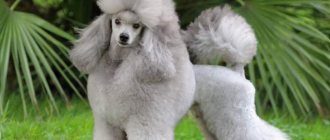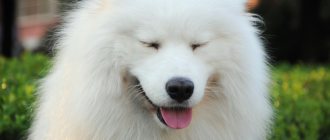Health
On average, a poodle can live 13-17 years. With proper nutrition and care, a pet can become a long-liver and live up to 18-19 years. Representatives of this breed have weak points in their bodies; the owner should be aware of them. Poodles are predisposed to the following diseases:
- Urolithiasis – the essence of the disease is simple: the bladder fills with stones of different sizes, which block the urinary canals, causing unbearable pain.
- Epilepsy is a disease in which the functions of the brain are impaired. It usually manifests itself as seizures, convulsions, and excessive salivation.
- Legg-Calvé-Perthes syndrome is an aseptic necrosis of the head of the femur, most often occurring in toy poodles.
- Joint dysplasia – joints become deformed, lameness and severe pain occur.
- Dilated cardiomyopathy is an idiopathic disease characterized by poor myocardial contractility with (or without) arrhythmia.
- Von Willebrand disease is a hereditary disease characterized by blood clotting disorders and spontaneous bleeding.
- Skin diseases.
- Sebaceous adenitis is a pathology characterized by disruption and destruction of the sebaceous glands.
- Progressive retinal atrophy is a set of pathological processes with dystrophic degeneration of the retina.
- Dislocation of the kneecap.
- Obesity.
- Diseases of the ears.
- Diabetes.
- A cleft of the hard palate is a congenital defect that is a tear or hole in the middle part of the palate.
- Gingivitis is partial or complete inflammation of the gums. It manifests itself as swelling and redness of the gums, which can lead to abscesses and tooth loss if not treated promptly.
The dog must be brought to the veterinary clinic at least once a year for preventive examinations. The owner must ensure that vaccination is carried out on time
It is also important to treat your pets for external parasites.
Vaccinations and susceptibility to disease
At 7–8 weeks, toy poodle puppies receive their first vaccinations against the most common diseases:
- plague;
- parainfluenza;
- parvovirus enteritis;
- hepatitis A;
- leptospirosis.
10 days before vaccination, dogs are treated against fleas and ticks. After about 21 days, pets are vaccinated again to strengthen immunity, with the addition of a rabies vaccine. The veterinarian can adjust the schedule based on the individual characteristics of the puppy and the infectious situation in a certain area. Adult animals are vaccinated annually.
The Toy Poodle dog breed is prone to many diseases, including:
- diabetes;
- epilepsy;
- urolithiasis disease;
- hypothyroidism;
- pathological hair loss (alopecia);
- tonsillitis;
- non-closure of the ductus Botallova;
- Gelineau's disease;
- microphthalmia;
- cataract;
- Addison's disease;
- blood clotting disorder;
- dislocated kneecaps.
Older dogs often go blind and deaf. Toy poodles are very fragile, so they often get injured.
On a note. The breed has an easily excitable character, so neuroses are common among its representatives. If the skin is inflamed and the dog is actively licking itself and biting itself, you should consult a veterinarian.
Life expectancy of a toy poodle
Small dogs usually live longer than large ones – the toy poodle is no exception. Despite the predisposition to many pathologies, the average life expectancy of the breed is about 15 years. With careful care and good heredity, the dog will live 2-3 years longer.
On a note. It is a common belief that male poodles live longer than female poodles. However, the lifespan of a dog does not depend on gender.
Education and training
Maltipoo dogs are not stupid and a little vain, so they easily master simple acrobatic tricks and are happy to demonstrate them to people. On the other hand, you need to find an approach to the breed (not to be confused with outright fawning). Maltese and toy poodle mixes cannot stand rudeness and commanding tone; it is also impossible to force them to do something against their will, so start working with your puppy from the day he appears in your home.
Experienced owners claim: the brain of a two-month-old Maltipoo is completely ready to begin to absorb basic educational material. But animals, whose upbringing and training were postponed to a later date, are no longer so pliable and smart. Early socialization of the Maltipoo won't hurt either. The label “designer pet” should not turn dogs into recluses who have no idea what is happening outside the walls of the apartment. Otherwise, the principle of training furry charmers is similar to the method of training the same Maltese lap dogs. Engage your maltipoo in a new activity that is unusual for him, do not prolong the lessons (5 minutes of exercise and then a break), desperately praise the dog for any, even the most insignificant achievements, or treat him with something tasty.
How advisable it is to teach a Maltipoo the basics of OKD, the owner will have to decide for himself. However, knowledge of basic commands like “Ugh!” and “Come to me!” It definitely won’t harm the breed, since picking up food left by someone unknown from the ground is dangerous for any animal. As an alternative to OKD, you can consider the Controlled City Dog course. And don’t let the decorative and designer status of the breed confuse you, because even it does not exempt the Maltipoo from the need to obey human demands.
Pros and cons of poodles
Poodles have many positive and negative qualities.
Let's first look at the reasons why you should get a poodle:
- Excellently trainable. Poodles like to learn new things, they willingly follow commands, especially when they see that it pleases the owner;
- Poodles are not noisy. If you are absent from work, then the poodle will not howl in anguish and irritate the neighbors - he will patiently wait for you. They do not bark with delight or whine for no reason, especially if the dogs are well trained;
- Poodles hardly shed, and this is a definite plus for keeping poodles in apartments. This is also a plus for people who suffer from allergies but really want to get a dog;
- Poodles live a very long time - up to 18 years with good care. This is a significant period for a purebred dog;
- Poodles are good-natured, flexible and cheerful animals. They love to play with children, willingly make contact and do not show aggression.
However, poodles have the following disadvantages:
- Poodles take a long time to adapt to a new home. This applies to both puppies that have just been taken from their mother and adult dogs. For example, a poodle will be sensitive to moving, and giving an adult dog to other owners is a tragedy for the pet;
- Poodles have many chronic diseases;
- Although poodles' curly hair does not fall out, it grows quickly and clumps together. You will have to take care of your pet’s fur for a long time and carefully;
- Poodles do not tolerate noise well. They don't like the sounds of repairs or loud screams;
- Poodles need physical activity because they were originally hunting dogs that ran and swam a lot.
Mating
Mating can be tribal or informal. In order for the puppies to have status and pedigree, you need to contact the nursery for a certificate for mating. A special form is filled out by the owners of the bitch and dog. The price for mating is set by the boy's owner. Usually it is 30% of the cost of puppies or one puppy. If the girl turns out to be empty, the mating is not paid for.
To determine the date, you need to monitor the female's cycles. The first heat usually begins at 8-10 months, but this period is considered too early. The best time for mating is 13-15 days of the third estrus: when the loop becomes loose and the discharge is light.
Standard Poodles are large dogs that need a lot of space. The dogs are usually walked together and brought into the territory of the male dog. For the solution (the first time), you can invite a specialist who will help pets and owners understand the procedure. Usually the animals are helped: they are held and directed towards each other. The act will last no more than 10 minutes. In the absence of a lock, the female may be complete, but it is better to re-mate after 48 hours.
Appearance
The Poodle gives the impression of being an energetic and intelligent dog with a strong sense of self-esteem. The physique is harmonious, moderately elongated. Sexual dimorphism is well expressed. There are four height variations in the breed.
The standard specifies only height, there are no strict restrictions on weight.
- Large: height - 45-60 cm; weight - 15-23 kg.
- Medium: height - 35-45 cm; weight - 8-15 kg.
- Dwarf: height - 28-35 cm; weight 5-7 kg.
- Toy: height - 24-28 cm; weight: no more than 5 kg.
The American Kennel Club (AKC) Standard specifies only three size variations: standard, miniature and toy poodle.
The head is proportional to the body, well sculpted. The width of the skull is less than half the length of the head. The stop is slightly expressed. The muzzle is straight and looks strong. The lobe is well developed, with open nostrils. The lips are of medium thickness, dry, moderately developed, the upper one lies on the lower one, but does not overlap it. Scissor bite. The eyes are located at stop level, the eyelids are almond-shaped. The color is black or dark brown, in brown poodles it is dark amber. The eyelids fit tightly. The ears are quite long, falling along the cheeks, set just below the outer corner of the eyes. The neck is strong, slightly convex, of medium length, oval in cross-section, somewhat shorter than the head, which allows the head to be carried high and proud.
The body is of good proportions, moderately stretched format. The back is straight. The croup is rounded, not sloping. The chest reaches the elbows, the ribs are oval. The stomach is tucked. The tail is set high, can be long, shortened by 1/3 or 1/2 of the natural length. When at rest it is lowered, when in motion it rises. The forelegs are completely straight, with good bone and muscle. The hind limbs, when viewed from behind, are parallel, the muscles are well developed and noticeable. The paws are small, closed, forming a short oval. The pads are thick and hard, the claws are strong.
The poodle has a characteristic gait that attracts attention: relaxed, confident, springy, with a short stride. She looks like the trot of an Arabian horse, the most elegant among horses.
The coat is curly to a certain length. As it grows, it forms cords.
- The curly coat is abundant, fluffy, well curled, and springy. Hair of uniform length, forms curls.
- Corded wool is thick and fluffy, forming cords of approximately the same length.
The color is even, uniform, not weakened: brown, black, white, gray, fawn (Faun).
Non-standard colors: phantom, harlequin and others
In addition to those recognized by the standard, there are other poodle colors. Black and whites are called harlequins, and even rarer black and tans are called phantoms. Separate standards have been developed for these dogs, which were recognized by the RKF in 2011, but not recognized by the FCI. At shows of the CACIB rank, harlequins and phantoms are exhibited in group 11 “unrecognized breeds”.
Some breeders purposefully breed harlequins and phantoms; sometimes “non-standard” puppies are born from purebred poodles of a solid color. Both varieties can be of any height variation.
There are other colors of poodles that are becoming more and more popular every year: sable, blue, brindle, white-brown, etc. If such puppies are born as a result of a planned mating, they receive a metric like the rest, but with the mark “rejected.” The document can be exchanged for a pedigree, but such a dog is not allowed for exhibitions and breeding.
What is the difference between a toy poodle and a miniature poodle?
The main difference between a toy poodle and a toy poodle is height. The height of the first is 24–28 cm, the second is 28–35 cm. Another difference that is noticeable only to experts is the degree of expression of the occipital protuberance. In a toy poodle it may be slightly different - a little less noticeable.
However, other signs of dwarfism (sharp stop, spherical skull, snub muzzle) are excluded. Otherwise, the dogs are small copies of their larger counterparts, have the same proportions and are judged to the same standard.
Health and life expectancy
Unfortunately, most modern poodles cannot be called healthy and problem-free dogs. The breed has a genetic predisposition to a number of diseases. Most of them are not fatal, but require attention and preventive or therapeutic measures. Of course, this does not mean that every poodle will suffer from all of the above, this is just a list of possible problems that have previously been reported by breeders or simply owners.
- Irregular structure of the lacrimal canaliculi.
- Atypical eyelash growth.
- Progressive retinal atrophy.
- Pathologies of the structure of the heart and coronary vessels.
- Deafness (more often in white dogs).
- Epilepsy.
- Otitis.
- Dermatitis caused by skin sensitivity to external irritants (parasites, cold, heat, ultraviolet radiation) or bacterial inflammation of the hair follicles.
- Allergy.
- Disorders of metabolic processes associated with the pancreas (diabetes, pancreatitis).
- Urolithiasis disease.
- Adrenal cortex insufficiency.
- Dropsy of the brain (more common in miniature poodles).
- Knee subluxation.
- Hip dysplasia.
- Predisposition to dental diseases (delay in changing teeth, early tooth loss, stone formation).
It is important for poodle owners to pay attention to disease prevention: timely treatment for external and internal parasites, strict adherence to the vaccination schedule, and an annual medical examination. Life expectancy is 13 years or more. There are many long-livers among poodles, but in old age many of them almost completely lose their hearing, vision and teeth.
There are many long-livers among poodles, but in old age many of them almost completely lose their hearing, vision and teeth.
Life expectancy is 13 years or more.
There are many long-livers among poodles, but in old age many of them almost completely lose their hearing, vision and teeth.
Character and habits of toy poodles
All varieties of poodles are distinguished by their quick wit and fairly high intelligence. Such dogs learn very easily and with interest, and also master complex tricks with great pleasure. If an animal lives in a family, then it very quickly remembers the most frequently used phrases of the people around it and over time begins to understand everything that is said to it.
Toy poodles are active and cheerful dogs. They become very attached to their owners and require constant attention; they do not tolerate loneliness quite well, which is why it is better not to leave them alone in the apartment for a long time. If your toy poodle is left alone at home all day, you should definitely get a second pet (cat or dog).
Toy poodles are very willing to play with children, but the behavior of the latter should be delicate and not cause any unpleasant sensations to the animal. When children impose their company too much on a dog, it can show its hunting nature and even bite. For this reason, adults should clearly explain to the child that a pet is not a toy, but a family member whose feelings and desires must be respected.
The toy poodle is always friendly and tolerant towards other pets. The dog can readily communicate with both small and large dogs, as well as cats. The Toy Poodle is very friendly to strangers and will willingly play with unfamiliar house guests if they so desire. The dog is completely indifferent to ordinary passers-by on the street.
Due to its intelligence and intellectual development, this breed is able to quickly learn not only the simplest commands, but also more complex ones. Dog experts recommend training a puppy in a playful way, and a separate lesson should not last more than 15 minutes. Another piece of advice from dog trainers: repetition is the mother of learning. Therefore, you need to repeat the lessons constantly - even several times a day.
Care and maintenance
A pet cannot be classified as an unpretentious type. If the owner has limited time, it is better to choose another option. The main problem may be the dog’s thick coat, which needs trimming and constant combing.
Caring for a miniature royal poodle consists of several procedures:
Combing wool. The animal is hypoallergenic - this is true. But this characteristic has its consequences; the toy poodle requires special care. Your pet's coat is not capable of shedding, so brushing will be required every 2-3 days. Careful care will prevent the formation of tangles and tangles. If the hair becomes tangled, you need to lightly wet the curls with a spray bottle. Haircut or grooming. The dog gained fame thanks to its unusual haircuts. You can see such works of art at performances in front of the public. But constantly giving your pet complex haircuts in a salon will be expensive. The pet's fur grows at an incredible speed - the dog needs to be cut once every 1-1.5 months. Only a few of the possible haircuts are included in the standard. Bathing and ear cleaning. A full bath once a week and washing of paws after each walk will be required. You can prevent water from getting into your ears by covering them with cotton wool soaked in Vaseline. Diseases of the Miniature Poodle include ear infections
Therefore, it is important to clean your ears every week with a cotton swab dipped in chamomile infusion. For bathing, you need to use high-quality shampoos with neutral pH and conditioners.
For combing, it is better to have several devices: a comb and a massage brush with natural bristles.
Special attention should be paid to trimming claws. Before trimming the nail, remove any unwanted fur from the paw pads.
This will reduce the risk of injury from such an event. Teeth are brushed once a week with a special paste for dogs.
Due to the complete absence of undercoat, the dog gets very cold in winter. You should purchase warm clothes. It is also unacceptable to place a pet on the street - this is an exclusively domestic pet.
Poodle character
Poodles, whose appearance is distinguished by sophistication and elegance, are often called “feminine” dogs, which is completely unfair. Do not forget that the ancestors of this dog with a delightful appearance were hunting dogs. From them the poodle inherited mobility, energy, and a love for an active lifestyle. He loves sports games with a ball, jogging with his owner, and swimming gives him the greatest pleasure. However, the dog will also not mind lying on the sofa with the owner and watching TV series.
Poodle with baby
The poodle is distinguished by its extraordinary intelligence and quick wit. They say about him: “A poodle is not yet a person, but it is no longer a dog.” It is the poodle's intelligence and intelligence that determine its behavior, which demonstrates unparalleled obedience. It may even seem that this dog is a people-pleaser, but in fact he idolizes his owner and recognizes him as an indisputable authority, since he realizes that he is smarter than himself. The dog supports the “leader” in all his actions, and does not consider it necessary to contradict him. If the owner starts digging up soil in the garden, the poodle will immediately join in the work and begin digging nearby, and if he decides to sit down and admire the sunset, he will certainly settle down next to him and will selflessly watch this action.
Natural observation, intelligence, memory, and curiosity help the poodle to capture all the nuances of communication - changes in the owner’s facial expressions, gestures, intonations - predicting his further actions and wishes. The dog is ready to do anything, just not to upset the owner, so he strives to exactly follow his instructions, and sometimes manages to do this even before he has expressed his wishes. If a poodle has made a mistake, by its behavior it will demonstrate that it asks for forgiveness, has realized everything, and will not happen again.
The poodle's ability to perceive human speech is excellently developed. It is believed that he knows more than 70 words. But fans of this dog breed are convinced that this number is excessively underestimated. Moreover, poodles understand many words by following the movement of a person’s lips. This gift allows them to become excellent companions for deaf and mute people.
The poodle is a very sociable dog. He needs communication not only with the owner, but also with all family members. At the same time, the innate sense of pride does not allow the poodle to be intrusive. The owners of this dog must understand that it needs signs of attention and manifestations of love. Otherwise, the poodle may well become depressed and even get sick.
Poodle with cat
Poodles love children. They are ready to be both friends and guardians at the same time. By the way, the poodle’s ability to care can manifest itself in relationships with all family members, regardless of their age - in this the dog realizes its shepherd’s inclinations.
The poodle is not aggressive and completely harmless. The attitude towards strangers depends on whether he liked the person or not. But in extreme cases, he can bark at someone he doesn’t like. Poodle guards are useless, but if they sense danger, they will certainly notify the owner with a ringing bark.
Poodles get along well with pets living in the same household, including cats. However, representatives of the cat family who are not familiar to the dog may suffer if the hunting instinct arises in him.
The main character traits of poodles of different height categories are almost identical, but the character of a toy poodle may contain some cowardice, manifested in a fear of loud sounds and sudden movements. This deficiency can be corrected through proper education. The Toy Poodle is less energetic than its counterparts.
Small poodlesStandard Poodle Colors
Black color is a classic, and many owners of black poodles note that the quality of their coat is much better than that of dogs of other colors. The ideal poodle has a deep black coat color, with no brown or gray tints and no white or silver guard hairs. The skin appears gray and even has a tinge of blue. The nose, eye rims, lips, claws are black, and the eyes are always brown.
White poodles are also quite common and have a number of features. Most puppies are born with cream or apricot patches on the chest, ears, and lower legs, but as they age, the coat becomes white. The skin is pink or truffle (spotted). The nose, eye rims, claws are black, the eyes are always brown. Puppies may be born with pink noses and paw pads, but their noses darken as they age. It happens that white puppies are born to dogs with colored fur, but such puppies are considered full-fledged, and in the future they will not give birth to colored offspring.
The silver color of poodles is characterized by shades of gray, but the shades should not be close to white or black. Silver is a very complex color that takes 2-3 years to develop. Puppies are born black, the color of the coat gradually changes. At the age of 6 weeks, the puppies should already have a visible silver color on their faces and limbs. To correctly determine the color, you need to shave the poodle, then the silver tint of the hair at the root will be noticeable. The eye rim, nose, lips are black, and the eyes are always dark brown. Skin color to match the coat.
Brown or chocolate poodles are distinguished by a dark brown coat color without beige or light brown shades and not close to black. On the ears, the tips of the hair are lighter. Leather to match the fur. The rims of the eyes, lips, claws are dark brown or black, the nose is liver-colored, while at exhibitions preference is given to poodles with a darker nose. The eyes are dark brown or dark amber. As puppies grow older, they lose color intensity, and then confusion in tones often occurs.
Apricot Poodles have coats of varying shades of apricot color, but the shades should not be close to white or dark brown. The ears are slightly darker than the base coat color. Puppies are born with a darker shade of apricot, but within two years the color is finally formed and the coat becomes lighter. Apricot Poodles often lose color and become creamy with age. The skin is white or pink and may have shades of gray or blue. The nose, eye rims, lips, claws are black or brown, eyes are brown.
Red Poodles have a rich, dark apricot or mahogany color. With age, the coat may become lighter in color. Skin color to match the coat. The rims of the eyes are brown, the pigmentation of the lips is dark brown, almost black, the nose is black or brown. By the way, puppies are born with black noses, but with age, some have a lighter nose. The eyes are brown, while poodles with brown noses have lighter eyes. The claws are dark brown or black.
At the end of 2007, the RKF recognized several more poodle coat colors, namely harlequin and black and tan. It should be noted that in America, Germany, the Czech Republic and some other countries they are also officially recognized. By the way, the cost of poodles with phantom and harlequin colors is higher than the cost of individuals with standard coat.
Harlequin – the main color is white (approximately 60%), while the border between white and black is clearly visible. Usually the line from the bridge of the nose to the first cervical vertebra (not always), the limbs, chest, belly are white, the head is black, there are 2-3 black spots on the back, and the tail can be completely or partially (at the base or tip) black. Eye rims, nose, lips, claws are black, eyes are dark brown. Most often, these puppies are born as a result of crossing white with light brown skin and black or gray poodles with the spotting gene.
Essentially, black and tan is a phantom color, but it includes not only black and tan poodles, but also poodles whose main coat color is brown, red, and silver. Therefore, the description will be general - the main color is dark (approximately 80%), there are tan marks on the eyebrows, muzzle, chest, along the edges of the ears, on all limbs, around the anus. Black tans come in apricot, gray, red, silver, cream, and brown colors. Browns have apricot tan marks, while reds have lighter shades of red and apricot. Silvers have tan markings in varying shades of gray and cream. Pigmentation, eye and skin color depend on the base color of the coat.
Description
Toy is very reminiscent of his standard relative. He is harmoniously built, body weight correlates with height. The coat is wavy, light, and movements are relaxed and free, since the toy dog is light in weight. How much does that one weigh - maximum 7 kg. The male's height is 28 cm. The toy and the dwarf relative, although they look similar in the photo, but the difference between these breeds is their weight and height.
Toy's face looks like a fox; he has flat cheekbones, an oval shape and a slightly elongated forehead. The eyes are almond-colored and look interested and attentive. The rectangular ears are elongated and rounded at the ends. The body is not elongated, the narrow back is proportionally correlated with strong limbs. The tail of the breed is bent at a slight angle.
There are several color options:
- Black is recognized as classic, and without any admixtures of white, brown or gray.
- Red, apricot, mahogany, red. The coat of puppies is richer and darker than that of adult dogs, which can become generally cream-colored.
- White is also a common shade. At birth, the dog has reddish areas on its coat, but with age they are “washed off”, giving way to a pure white color. Such pets may have a subtle pink tint - this is very unique and original.
- Silvery - is formed over several years, at most three. Born puppies have a rich black color, which over time acquires whitish hairs. A 6-week-old puppy already has silver on its paws and face.
- Brown is a rich, almost chocolate color.
Price
The average cost of a good dwarf poodle with documents is 30-35 thousand rubles.
Pet-class babies cost from 15 to 20 thousand, puppies of rare colors or born from outstanding parents and almost certainly promising to grow into champions cost more - their cost can reach up to 55-60 thousand rubles.
However, future owners of miniature poodles who are just thinking about purchasing such a pet need to understand that in addition to responsible breeders who spare no effort, time or money to contribute to the improvement of the breed, there are also so-called divorcees.
They differ from breeders in that they do not care about the quality of the resulting stock, and often the health of the puppies. Also, many of them pass off wishful thinking and, for example, under the guise of dogs of a rare color, they sell very ordinary puppies that are not particularly distinguished by the rarity of their coat color.
Important! In order to be confident in the quality and health of the dog you are buying, you need to purchase such a pet only with documents: from a breeder or in a nursery where they are truly interested in getting magnificent puppies
How to choose the right puppy?
In childhood, toy poodles cannot be distinguished from larger varieties, so it is better to buy puppies from nurseries that have proven themselves on the positive side. Before purchasing, you should learn more about the nature of the breed, visit exhibitions, and communicate with current owners.
A responsible breeder will be happy to talk about his charges and inform about the characteristics of each of them - the puppies are always distinguished by their quality. He will not refuse to meet his parents. Dogs must have good conformation, behave in a balanced and friendly manner. Defects not only in appearance, but also in character are inherited.
After examining the litter, you should choose the most active and nimble baby.
His health is evidenced by:
- clear eyes;
- skin without redness or ulcers;
- a neat fur coat without an unpleasant odor;
- a body without any traces of excess weight or exhaustion.
The fact of purchase should be confirmed by a purchase and sale agreement in order to protect yourself from purchasing a mixed breed or a sick dog. Along with the document, the breeder must give the new owner a veterinary passport and the puppy’s birth certificate, which is subsequently changed to the pedigree.
Popular colors of toy poodles
The coat of the toy poodle is curly, thick, with fine guard hairs. The hairs themselves are quite elastic and resist being compressed. There are also individuals with coarser corded fur. There is no undercoat, and there is no dog smell either. Toy poodles do not actively shed and their fur does not cause allergies.
The Toy Poodle comes in a wide variety of colors. Only six options have been officially approved (according to the standard), but in reality there are many more. After all, when crossing dogs with different coat colors, the color of the offspring can turn out to be the most unpredictable. Yes, such dogs will not be allowed to show, but in all other respects they will be quite decorative and cute.
Dogs of the Toy Poodle breed have the following colors:
- White. The most common and popular color today. The toy poodle with white fur looks very noble. Puppies may have a faint cream or apricot tint to their coat, which fades over time. The skin of a white dog is usually pink, less often spotted. The nose and claws are black, the eyes are brown;
- Black. Classic color. In this case, the color of the coat should be extremely even, without spots of other colors or a reddish tint. Paw pads, claws, nose - only black, without any multi-colored spots. Skin - gray or blue;
- Brown (chocolate). The coat has a uniform, rich brown color without spots. The fur on the ears is a little lighter. The nose is brown, the eyes are amber or brown;
- Silver. The coat is an even silver-gray color. It is interesting that this color is formed only by 2-3 years of a dog’s life, because puppies are born with black hair. However, according to some signs, dog lovers can identify silver color starting from six weeks. At the same time, the eyelids, nose, lips are black, and the eyes are dark brown, almost black;
- Red (mahogany). Coat color is dark red. Nose, eyelids, lips - brown or black;
- Apricot. All apricot shades are allowed - from dark to light. As a dog ages, its coat becomes lighter in color. Very old dogs have a cream colored coat. Skin color is pink, much less often blue. The color of the eyelids, nose and lips is black or brown.
In 2007, two more colors were added to the Toy Poodle breed standard - white and black (harlequin) and black with tan (markings) of any color.
Puppies
A mother dog can feed her puppies milk for about 60 days. Around the middle of this period, babies begin to be fed with low-fat cottage cheese, yogurt or kefir, egg yolk, grated apples, and finely chopped boiled beef.
In the new home, the toy poodle continues to be given the usual food - the slightest changes in the diet are fraught with digestive problems. You can gradually switch your puppy to ready-made food appropriate for his age. The transition takes at least two weeks.
With a natural diet, the diet is supplemented with:
- rice or buckwheat porridges cooked with milk or meat;
- vegetables - carrots, cucumbers, pumpkin;
- fresh herbs - spinach, dill, parsley, dandelion leaves.
At 4 months, sea fish is included in the menu. Puppies are given only fillet, thoroughly cleaned of bones. At the same time, by-products are introduced into the diet - liver, lung, tripe. When teeth change, the amount of fermented milk products rich in calcium is increased. To make the process easier, dogs are periodically allowed to chew sugar seeds.
At 6 months, a toy poodle eats an adult menu, but the total amount of food should be slightly larger as the pet continues to grow. The serving size is calculated individually, based on the baby’s needs. If the dog greedily licks the bowl, give a little more food. If the dog does not eat food within 20 minutes, the amount of food is slightly reduced.
Toy poodle feeding frequency per day:
- 1–2 months – 5 times;
- 2–5 months – 4 times;
- 5–7 months – 3 times.
From the age of 8 months, a toy poodle receives food like an adult dog - twice a day.
Origin story
Everything that is known for sure about this breed at the moment points to its rich historical past, going back thousands of years. Primitive images of these animals were found on ancient Roman and Greek coins, as well as on the stucco molding of some temples.
At various times, many European countries were considered the birthplace of this breed. Most often, preference was given to Hungary, Germany and France, where this breed began to be used in the Middle Ages. Initially, poodles were used exclusively as a hunting breed - they caught shot prey from ponds and swampy areas. From German, the word “poodle” is literally translated as “swamp” or “puddle”; from English, puddle also means “puddle”.
In French, the breed is called "caniche", which comes from the expression chien canard, which translates as "duck hunting dog".
It is believed that poodles were formed by crossing several different breeds at once. Among them were: barbet, bullets, commander, retriever, toy spaniel, bichon. It is known for sure that the breed gained its real popularity precisely in the 18th century, when poodles entered the European market and almost instantly became pets of rich and eminent people. Previously, grooming services were opened in France - specialized salons for caring for dog hair, and with the advent of poodles, their activity was able to gain momentum significantly.
At one time, poodles became favorites of such famous personalities as Marie Antoinette, Schopenhauer, and Ludwig van Beethoven. They all admired the beauty, grace and intelligence of these pets. It is also known that some breeds of poodles were bred specifically to participate in military battles. These dogs could carry food, supplies and reports unnoticed by the enemy, as well as find wounded people and drag them away from the battlefield.
This variety received official recognition only in 1886, when the world's first standard of this breed was published. A little later, a similar document was drawn up in France and Germany. This breed also came to Russia in the 19th century, and the dogs became favorite pets of many representatives of the Russian nobility.











